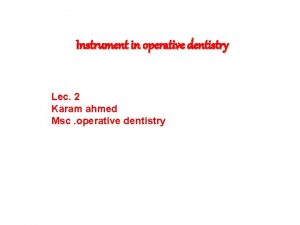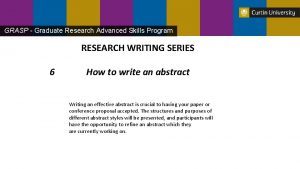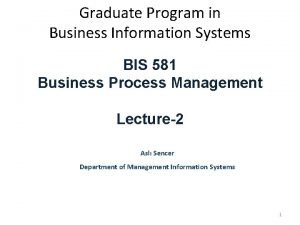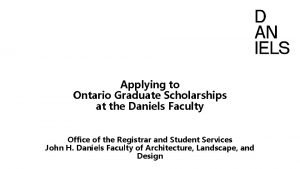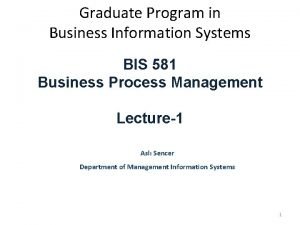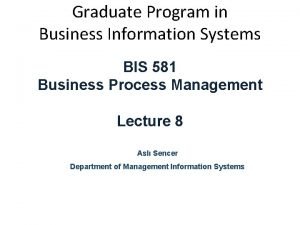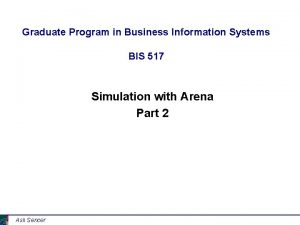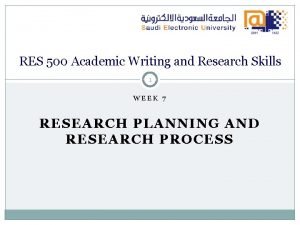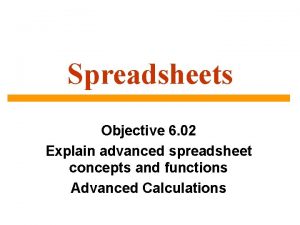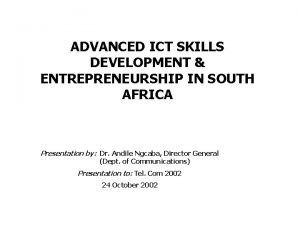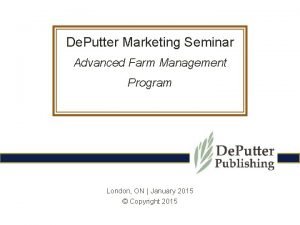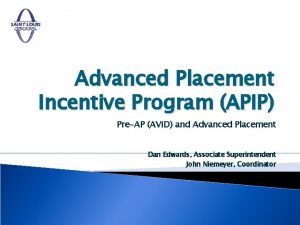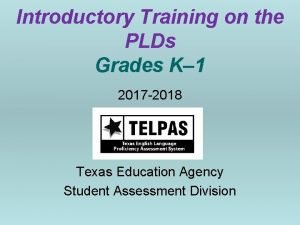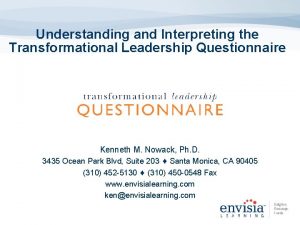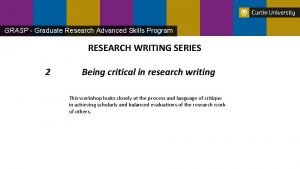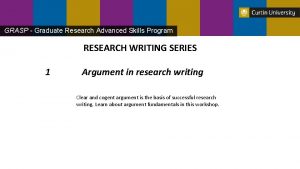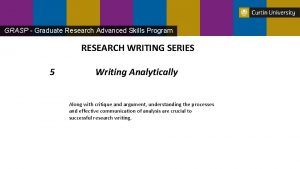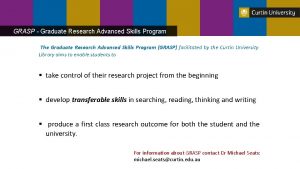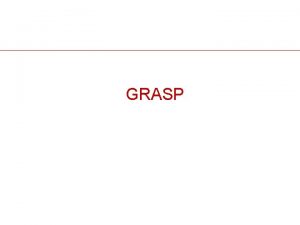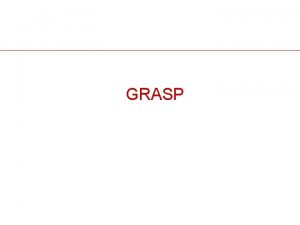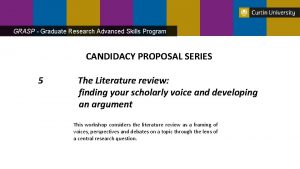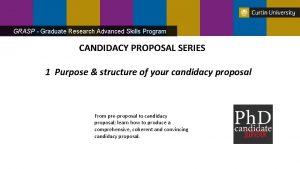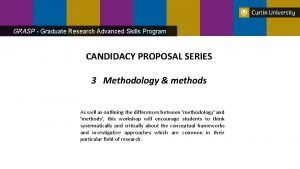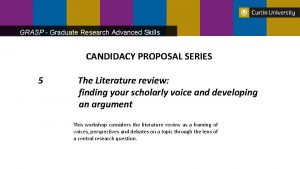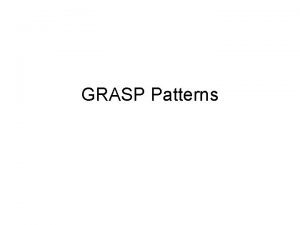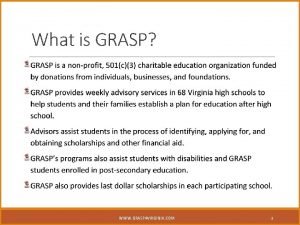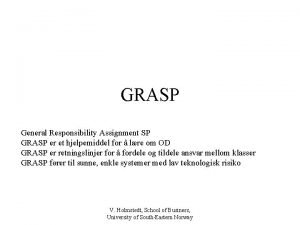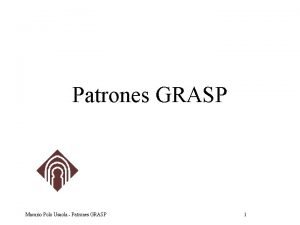GRASP Graduate Research Advanced Skills Program RESEARCH WRITING




















- Slides: 20

GRASP - Graduate Research Advanced Skills Program RESEARCH WRITING SERIES 6 How to write an abstract Writing an effective abstract is crucial to having your paper or conference proposal accepted. The structures and purposes of different abstract styles will be presented, and participants will have the opportunity to refine an abstract which they are currently working on.

6 How to write an abstract AIMS OF TODAY’S CLASS By the end of the workshop, participants will • have been introduced to the styles and purposes of different forms of abstract • have read a range of abstract examples • understand the elements of an effective abstract • have practiced writing and refining their own abstract

6 How to write an abstract WHAT IS AN ABSTRACT? An abstract is a snapshot or brief summary of a thesis, conference presentation or journal article. Some aims of the abstract of a journal article are to: • Historically contextualize the research in the area • Concisely present a problem/research question and your response to it • Outline the methodology/methods used in data collection and analysis • Indicate findings and discuss/interpret findings • • • Present possible implications of findings he findings Suggest the significance of this contribution to research in the field • Possibly indicate the limitations of the research and the prospects for and directions of future research

6 How to write an abstract WHY IMPROVE YOUR WRITING OF ABSTRACTS? Ø “The abstract serves as an advertisement for the article. ” (La. Placa et. al. 2018, p. 203) Ø “…the abstract can influence the reviewer to develop a favourable bias toward the manuscript. ” (La. Placa et. al. 2018, p. 203)

6 How to write an abstract AUTHORIAL ‘VOICE’ IN THE ABSTRACT Personal or Impersonal? Wallwork (2016, p. 223) identifies 4 possible styles in writing the abstract and the paper: STYLE 1 “I found that x = y. ” (first person singular – active voice) STYLE 2 “We found that x = y. ” (first person plural – active voice) STYLE 3 “It was found that x = y. ” (passive voice) STYLE 4 “The authors found that x = y. “ (third person plural – active voice)

6 How to write an abstract What tenses should be used in the abstract? The two most common tenses used in an abstract are: PRESENT SIMPLE • Describe what author is trying to show: “We show, we investigate…” • Describe a common opinion or view of the topic: “The phenomenon is essentially random…” • Refer to action carried out in experiments: “We show that such and such is the case…” • Give conclusions: “X appears to have a strong positive correlation with Y, despite…. ” PAST SIMPLE • Describe what they did “The authors examined…and found that…” Wallwork (2016, p. 225)

6 How to write an abstract What tenses should be used in the abstract? Both the present perfect and the present perfect continuous tenses describe a situation which was true in the past, and is still true now. PRESENT PERFECT “These phenomena have been studied for decades. ” PAST PERFECT CONTINUOUS “Such results have been appearing in the literature since 1978. ” Wallwork (2016, p. 225)

6 How to write an abstract THE BASIC LOGIC OF MANY ABSTRACTS FOLLOWS THE The IMRAD model I Introduction M Methods R Results A And D Discussion

6 How to write an abstract THE BASIC LOGIC OF WRITING ABSTRACTS FOLLOWS THE IMRAD Model (Wu, J. 2011, p. 1346 )

6 How to write an abstract DIFFERENT TYPES OF ABSTRACT • Descriptive abstract Is often very short – no more than 100 words. • Informative Abstract Does much more than describe; it is a concise summary of the article. Could be 200 -500 words. • Structured Abstract An abstract with clearly labelled headings and sections. Can be of variable lengths.

6 How to write an abstract DESCRIPTIVE ABSTRACT • Indicates the type of information found in an article • Avoids making judgements about the information • Does not provide results or conclusions • Does have key words; may include purpose, methods and scope • More an outline of the work, than a summary; usually a max of 100 words Abstracts - The Writing Center https: //writingcenter. unc. edu/tips-and-tools/abstracts/

6 How to write an abstract EXAMPLE OF A DESCRIPTIVE ABSTRACT (101 words) “Advanced literacy and the place of literary semantics in secondary education: A tool of fictional analysis” This article presents a tool of fictional analysis for secondary education that aims at providing standards of interpretation and allaying fears of standard imposition. The semantic core of the tool adapts the deontic, alethic, and axiomatic modalities used in Dolezel (1998). Four "extensions" are added to this core -- "cultural, " "visual, " "(meta)cognitive, " and "epistemic" -- which above all mediate between student experience and pure abstraction, and invite students to think with and about tools and texts rather than blindly apply models. The relationship of the tool with literary theory and the appropriate age for learning such a tool are also discussed. Candel, Daniel. Semiotica Vol. 195, Iss. 1 -4, (0, 2013): 305 -329.

6 How to write an abstract INFORMATIVE ABSTRACT • Covers all of the essential points of the paper • Summarises the background, purpose, focus, methods, results, findings and conclusions • Often comprised of one paragraph – but could be two or even three • Length can vary between 200 and 500 words • Often used in science, engineering and psychology https: //www. victoria. ac. nz/education/pdf/Writing_an_abstract. pdf

6 How to write an abstract EXAMPLE OF AN INFORMATIVE ABSTRACT - Humanities (229 words) Transformative Critique: What Confucianism Can Contribute to Contemporary Education Critical thinking is currently much celebrated in the contemporary West and beyond, not least in higher education. Tertiary education students are generally expected to adopt a critical attitude in order to become responsible and constructive participants in the development of modern democratic society. Currently, the perceived desirability of critical thinking has even made it into a seemingly successful marketable commodity. A brief online search yields a vast number of books that are mostly presented as self-help manuals to enable readers to enhance their critical abilities. But how should critical thinking be taught? Is it at all possible? Instead of attempting to provide a direct answer to this pressing question, this paper seeks inspiration in a culturally rather remote philosophy of education that hitherto has not been regarded as a stimulant for critical thinking, namely the ancient philosophy of Confucianism. The paper argues that not only are most if not all types of thinking regarded in the West as 'critical' also present in Confucianism, but also that the Confucian philosophy presides over a particular type which increasingly tends to be neglected in the contemporary West; a type that I call 'transformative self-critical attitude'. Through a comparison with the well-known Teaching Perspectives Inventory in higher education, the transformative self-critical attitude is used to elucidate some further aspects of the Confucian philosophy of education that may offer valuable insights to contemporary educators. Keywords: Critical thinking Confucianism Higher Education Teaching Perspectives Inventory John Dewey Sigurðsson, Geir. Studies in Philosophy and Education; Dordrecht Vol. 36, Iss. 2, (Mar 2017): 131 -146.

6 How to write an abstract EXAMPLE OF AN INFORMATIVE ABSTRACT – Science (257 words) “Can we use crop modelling for identifying climate change adaptation options? ” Marc. Corbeelsab. David. Berreb. Leonard. Rusinamhodzia. Santiago. Lopez-Ridaurac Agricultural and Forest Meteorology Volumes 256– 257, 15 June 2018, Pages 46 -52 Climate model projections coupled with process-based crop models are advocated for assessing impacts of climate change on crop yields and for informing crop-level adaptations. However, most reported studies are vague on the choice of the global circulation models (GCMs) for climate projections, and on the corresponding uncertainty with this type of model simulations. Here we investigated whether climate-crop modelling can be used for identifying crop management-level adaptation options. We focused our analyses on a case study for maize in southern Africa using the APSIM crop growth model and projections from 17 individual climate models for the period 2017– 2060 for the contrasting representative concentration pathways 2. 6 and 8. 5. Intensification of nitrogen fertiliser use (from 30 to 90 g a− 1) was simulated as an example of a crop management-level adaptation to climate change. Uncertainties in crop yield predictions were about 30 to 60%, i. e. larger than expected crop responses to most management-level interventions or adaptations. Variation in simulated yields was caused by inter-seasonal rainfall variability and uncertainty with climate models. Some GCMs resulted in significantly different maize yield predictions, without any clear pattern across sites. Given these high uncertainties, we argue that crop modellers should be cautious when informing future crop management adaptation strategies based on climate-crop model ensembles. A better use of crop models is the simulation of crop responses to current weather variability aiming at the identification of crop management practices for coping with climate variability. Promising practices can then be evaluated with farmers on their feasibility over a range of plausible future biophysical and socio-economic farming conditions.

6 How to write an abstract STRUCTURED ABSTRACTS An Example PURPOSE: To summarize the main findings from research on structured abstracts. METHODS: A narrative review of all the relevant papers known to the author was conducted. RESULTS: Authors and readers judged the structured abstracts to be more useful than traditional ones. In 1987 the Ad Hoc Working Group for Critical Appraisal of the Medical Literature proposed guidelines for informative seven-headings abstracts. In 1990 Haynes et al. reconsidered the structured abstract of clinical research and review articles and proposed revised guidelines. Nowadays, most abstracts are informative, and the most commonly used structure is IMRAD (Introduction, Methods, Results And Discussion) format. CONCLUSIONS: There are many variations in the structured-abstract formats prescribed by different journals. But even in recent years, not all abstracts of original articles are structured. More research is needed on a number of questions related to the quality and utility of structured abstracts. Key words: Abstracting and indexing. Review literature. Peer review Guimaraes, C. A. 2006: Structured Abstracts: Narrative Review Acta Cir. Bras. vol. 21 no. 4 São Paulo July/Aug. 2006

6 How to write an abstract ADVANTAGES of STRUCTURED ABSTRACTS • Guides the author to tell ‘a complete story in a nutshell’ • It ‘facilitates a faster search for relevant information’ by human or search engine SOME GOOD ADVICE Follow the logical order of the structured abstract (without headings) even if this order is not specified or rquired by the journal. (Wu, 2011, pp. 1348 -49)

6 How to write an abstract SUGGESTED STEPS IN WRITING AN ABSTRACT 1. Carefully re-read the entire paper, without interruption 2. Read each section and reduce each section to one or two sentences 3. Reread these sentences to see that no vital information has been excluded 4. Check to see whether you can slightly expand each of these points in the draft abstract 5. Check word length and adjust 6. Edit and check flow of transition and flow of ideas 7. Make key words 8. Check whether title matches contents of abstract 9. Do a final edit/proofread See https: //www. victoria. ac. nz/education/pdf/Writing_an_abstract. pdf

6 How to write an abstract Thinking about abstracts goes together with thinking about titles and keywords Start at 10 mins. 25 sec. Finish 15. 22 https: //www. youtube. com/watch? v=80 ZWb. X-E 92 g

6 How to write an abstract REFERENCES Brabazon, Tara. 2017. “Vlog 43. “Journal titles, keywords and abstracts. ” (Accessed May 28) https: //www. youtube. com/watch? v=80 ZWb. X-E 92 g Candel, D. 2013. “Advanced literacy and the place of literary semantics in secondary education: A tool of fictional analysis”. Semiotica. 195 (1 -4), 305 -329. Corbeels, M. et. al. 2018. “Can we use crop modelling for identifying climate change adaptation options? ”. Agricultural and Forest Meteorology. Vol. 256 -257, 46 -52. Guimaraes, C. A. 2006: Structured Abstracts: Narrative Review. Acta Cir. Bras. vol. 21 no. 4 São Paulo July/Aug. 2006. IEEE Professional Communicaton Society. “Preparing structured abstracts. ” (Accessed 28 May. 2018) http: //sites. ieee. org/pcs/transactions-of-professional-communication/for-prospective-authors/guidelines-to-follow/preparing-stru -abstracts/ Language & Learning Service, University of Adelaide’ 2005. ‘Writing an Abstract. Accessed 28 May, 2018. https: //www. victoria. ac. nz/education/pdf/Writing_an_abstract. pdf La. Placa, P. et. al. 2018. “How to write really good articles for premier academic journals. ” Industrial Marketing Management. 68 (2018) 202 -209. Sigurdsson, G. 2017. “Transformative Critique: What Confucianism Can Contribute to Contemporary Education”. Studies in Philosophy and Education. 36 (2) 131 -146. U. S. National Library of Medicine. 2018. “Structured Abstracts”. (Accessed 28, May 2018) https: //www. nlm. nih. gov/bsd/policy/structured_abstracts. html University of North Carolina 2018. ‘Abstracts. (Accessed 28 May 2018) https: //writingcenter. unc. edu/tips-and-tools/abstracts/ Language & learning Service Wallwork, A. 2016. Chapter 13: ‘Abstracts’ in English for writing research papers. Switzerland: Springer International Publishing. Wu, J. 2011. Improving the writing of research papers: IMRAD and beyond. Landscape Ecology (2011) 26: 1345– 1349.
 Inverted pen grasp dental
Inverted pen grasp dental Structured abstract
Structured abstract Bis graduate program
Bis graduate program Daniels registrar
Daniels registrar Woolworths graduate program
Woolworths graduate program Kpmg law graduate program
Kpmg law graduate program Bis graduate program
Bis graduate program Talent accelerator program
Talent accelerator program Bis graduate program
Bis graduate program Bis graduate program
Bis graduate program Auchan graduate program
Auchan graduate program Academic writing and research skills
Academic writing and research skills Advanced spreadsheet skills
Advanced spreadsheet skills Edunet south africa
Edunet south africa Advanced farm management program
Advanced farm management program Advanced placement incentive program
Advanced placement incentive program Telpas descriptors
Telpas descriptors Difference between interpersonal and intrapersonal
Difference between interpersonal and intrapersonal What is a soft skill
What is a soft skill Ontario skills passport essential skills
Ontario skills passport essential skills Transformational leadership questionnaire tlq
Transformational leadership questionnaire tlq
